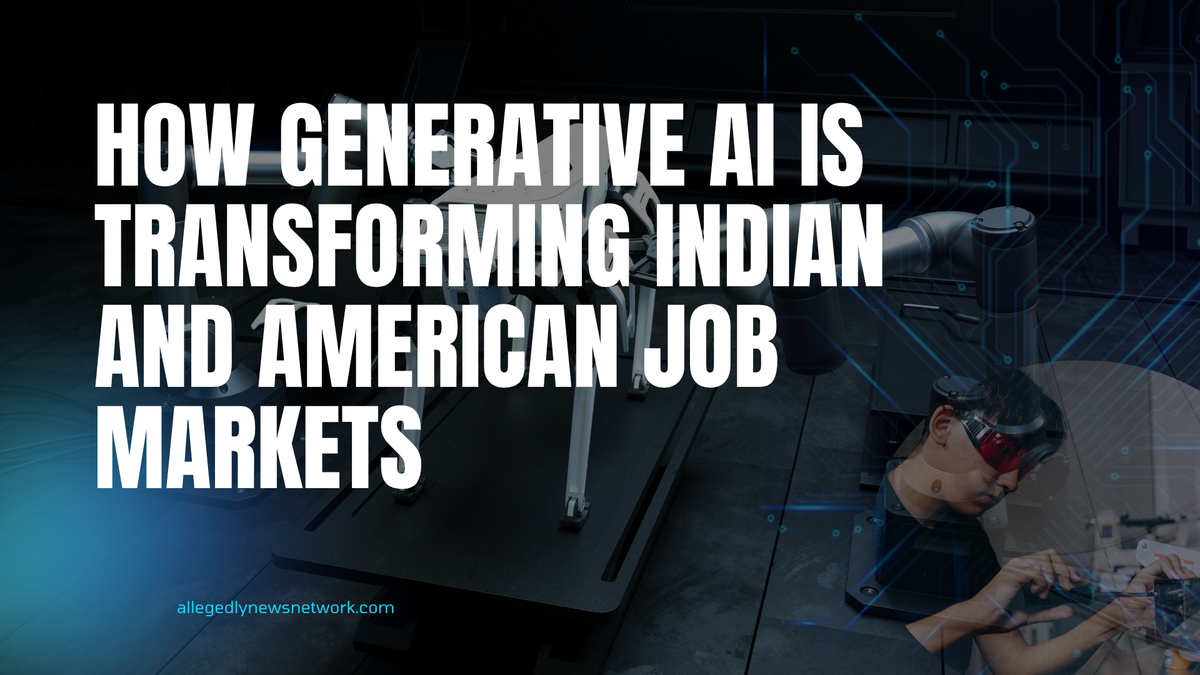How Generative AI Is Transforming Indian and American Job Markets
Generative AI is reshaping jobs in India and the U.S. disrupting roles, driving automation, and creating urgent demand for new skills and career paths.

Introduction: The Birth of Generative AI Careers 2025
Generative AI technique of artificial intelligence that can generate text, code, images, and more is no longer something out of a science fiction movie. Through its tools by 2025, industries are being actively changed, rewriting AI jobs India and generative AI jobs worldwide. Software development and marketing, customer support and manufacturing, and many more fields are seeing automation displace jobs as well as create new jobs.
This blog will:
- Spotlight upskilling and reskilling initiatives that aim to equip professionals with the skills needed for the AI-driven future.
- Examine automation trends and the proportion of job creation versus job displacement.
- Discuss industries being revolutionized in India and the U.S.
1. Industries Being Revolutionized: High-Impact Fields
A. Software & Technology
In the U.S. and India, coding and software maintenance are quickly incorporating generative AI. Copilot and ChatGPT and similar tools can create boilerplate code, write tests, and maintain documentation.
- India context: India's IT population—65% of off-shore IT work globally—is under threat from automation in low-skilled work, even as the need for AI-skilled professionals increases (en.wikipedia.org)
- U.S. context: McKinsey suggests 30% of the work hours of Americans could be automated by 2030, while software jobs would face moderate disruption (news.stthomas.edu.)
B. Customer Support & Call Centres
India has long dominated outsourcing, particularly call-center work. Generative AI chatbots are now taking the place of scripted jobs with clever, session-capable bots. Likewise, U.S. companies are embracing AI-powered customer service, cutting live-agent positions.
"TCS CEO K. Krithivasan foresees chatbots putting most call-center workers out of a job in a year( ft.com.)"
C. Marketing, Content & Creative Industries
According to Vogue Business, LVMH, Nike, and Estée Lauder are using AI in design and copywriting—encompassing entry-level creative jobs
- Generative AI can now create full marketing copies, create social-media posts, and customize product descriptions. (voguebusiness.com.)
- U.S. content-creation, journalism, and advertising professionals are increasingly threatened with task automation.
D. Finance, Legal & Administrative Support
- Brookings notes that paralegals, tax preparers, and analysts are seeing up to 50% of task disruption.
- Services that rely on data summarization, compliance, and document review are integrating AI tools.
E. Manufacturing & Blue-Collar Skills
Automation is increasingly moving into assembly, logistics, and machinery operations. Support roles will combine machine running with technical repair.
- In India, there is growing demand for robot technicians, maintenance experts for machines, and logistics coordinators. (timesofindia.indiatimes.com)
- Reskilling programs for blue-collar workers to accommodate hybrid jobs will also be witnessed in the U.S.
2. Automation Trends: What's Going Away—and What's New?
A. Job Displacement vs. Augmentation
- Up to 50% of new white-collar jobs may disappear by 2025—although much work will change, not cease
- McKinsey estimates that up to 30% of U.S. hours could be impacted by automation. while also seeing net productivity growth. (news.stthomas.edu.)
- Generative AI has the potential to increase India's labor productivity by 5.44% by 2030, automating 24% of activity and speeding up others
B. Underemployment & Overqualification
- Better-educated employees in emerging markets are commonly pushed into low-skilled work as a result of technology dislocation.
- In America, job applicants are also shifting to lower-skilled work when laid off.
- More than 60% of the underemployed Indian and African professionals are accepting entry-level jobs despite higher qualifications
C. New Careers: The Expansion Side of AI
As some jobs shrink, others are emerging:
- 2/3 of Indian firms are in active recruitment of diversified AI talent: World Economic Forum
- AI Operations Managers, Human-Machine Collaboration Experts
- AI/ML Engineers, Prompt Designers, Ethics Officers, Data Curators. (nweforum.org)
3. Upskilling & Reskilling: Strategies to Future-Proof Careers
A. Corporate & Government Initiatives
Microsoft's ADVANTA(I)GE India has already upskilled 2.4 million AI-ready professionals with a target of 10M by 2030
- IBM cut 8,000 employees in AI restructuring but initiated internal reskilling to enable redeployment. (en.wikipedia.org)
- IndiaAI Mission collaborates with OpenAI in launching OpenAI Academy, making AI education more democratic
B. Education & Apprenticeships
- Harvard Business Review advocates for shadowing and apprenticeships as the best reskilling technique.
- Engineers least confident in AI's impact—highlighting the necessity of formal training, India's NITI Aayog and Great Learning report indicate.
C. Skill Shifts: Complementary Over Substitute
- Entry-level jobs are moving increasingly towards human-in-the-loop, cross-functional AI jobs.
- Studies indicate demand for cognitive, social, and collaboration skills is increasing between 50% more powerful than routine task demand.
4. Strategies for Workers: Navigating Automation Trends
A. Task Audits & Career Audits
- Emphasize emotional intelligence, creativity, complex problem-solving—these are long-lasting strengths
- Use tools to analyze your job—if AI is capable of doing >50% of your work, risk of displacement is high; <30% indicates that AI can complement your role
B. Invest in High-Demand Upskill Trajectories
- For non-tech professionals—UX/UI, operations, healthcare, green tech fields.
- Data analytics, AI architecture, prompt engineering, cybersecurity
C. Lifelong Learning & Apprenticeships
- Partner with AI experts on cross-team "shadow projects."
- Embrace continuous learning: coding bootcamps, micro-credentials, internal apprenticeships.
D. Policy: Co-Design & Social Safety Nets
Ask firms to provide training subsidies and AI co-design grants (investopedia.com.)
- Lobby for social protections universal basic income, transition allowances, and lifelong learning vouchers.
5. What's Next: The 2025–2030 Outlook
- India: Boom in gen AI start-ups continues (240+ companies, $750M in funding).
- U.S: 3–4% annual productivity growth with AI; millions of mid-skill workers will require new occupations
- Global dynamics: Focus from job creation to job transformation—new horizons of AI-human collaboration, ethics, and governance.
A future that is attuned to generative AI will depend on:
- Value-shift toward distinctively human abilities.
- Public-private collaborations in skilling
- Agile, lifelong learning systems
6. Deep Dive: Where Job Losses Are Already Occurring
Generative AI is already starting to displace or decrease the demand for different categories of jobs, especially those that consist of repetitive or structured work. This displacement is not equal it differs according to education, location, and industry maturity.
Vulnerable Job Categories in India
- Call Center Managers: India's $38B BPO sector is likely to shed more than 640,000 low-skilled positions by 2030, Nasscom says. AI chatbots currently manage as much as 80% of Tier-1 support requests.
- Back-office Administrators & Data Entry Clerks: Infosys and Wipro are just a few of the companies that are automating invoice payment, payroll, and auditing—the jobs which were earlier employing hundreds of thousands.
- Junior Coders & QA Testers: With AI tools such as GitHub Copilot, low-level code review or test case writing by freshers is more and more obsolete.
"80% of Fortune 500 companies are now considering AI to automate repetitive digital work, particularly in India and the Philippines." – Gartner, 2024 Emerging Technologies Report
Job Displacement in the U.S.
- Paralegals & Legal Assistants: AI document review is minimizing headcount in law firms by 20–30%.
- Customer Service Reps: More than 250,000 U.S. customer support jobs could disappear by 2026 as AI platforms such as Intercom and Zendesk automate resolution processes.
- Marketing Assistants: In-house content departments are dwindling as AI platforms create entire ad campaigns, product pages, and email sequences.
7. New Job Formation: What's Emerging from the Ruins?
Even amidst the disruption, generative AI is giving rise to brand new categories of jobs, particularly in places where human guidance, creativity, or situational judgment is necessary. Indeed, the World Economic Forum foresees that AI will generate more jobs than it eliminates by the year 2030 but only for those who evolve.
New Roles Emerging in India
- Prompt Engineers: Experts who optimize prompts to receive optimal results from AI models such as GPT-4o or DALL·E. These roles did not exist 3 years ago but are in high demand across marketing and product teams now.
- AI Ops & Integration Specialists: As AI models are deployed in industries such as agriculture, retail, and logistics, India is experiencing a surge of AI implementation consultants and system trainers.
- AI Ethics & Governance Officers: Multinationals and tech startups are bringing on policy-focused experts to oversee fairness, bias, and model safety in generative AI outputs.
Emerging New Career Paths in the U.S.
- AI Content Curators & Reviewers: As AI creates bulk content, human professionals still need to fact-check, localize, and stylize final outputs.
- Human-AI Collaboration Managers: Positions that manage the balance between human input and automated workflows—particularly in healthcare, finance, and law.
- Behavioral Data Scientists: As AI becomes ubiquitous in consumer touchpoints, behavioral analysts are being recruited to anticipate user responses and personalize AI messages.
The World Economic Forum Future of Jobs Report 2025 lists the top 10 emerging job roles worldwide as:
- AI and Machine Learning Specialists
- Data Analysts and Scientists
- Big Data Engineers
- Digital Transformation Specialists
- Information Security Analysts
- Robotics Engineers
- Process Automation Experts
- Business Intelligence Analysts
- Fintech Developers
- Human-Machine Interaction Designers
8. Net Impact: Disruption vs. Opportunity
The Short-Term Cost
- Globally, generative AI will displace or redefine more than 1.1 billion jobs by 2030, PwC predicts.
- India and the United States will feel short-term friction—particularly among young professionals and underrepresented groups with less access to reskilling.
The Long-Term Opportunity
- The World Bank estimates a net increase in AI-related jobs across the globe by 50–70 million in 2030.
- India's AI job market is expected to be worth $17 billion by 2027, employing more than 3 million professionals in software, consulting, and operations roles.
The U.S. Department of Labor anticipates AI and data science jobs to increase 35% year-over-year through 2028, one of the most rapidly growing categories of jobs in U.S. history.
Conclusion
Generative AI is changing jobs more rapidly than earlier waves of automation. In India and the U.S., conventional jobs are declining—new, exciting opportunities arise where technology, creativity, and human-based competencies converge.
For professionals, the AI India jobs and U.S. jobs landscapes of 2025 present an empowering decision: fight change or surf the wave. It involves assessing jobs, reassessing competencies, and making investments in ongoing learning.
Don't simply follow along forge the next wave of generative AI professions.
Subscribe to Allegedly News Network for actionable intelligence on automation trends, job futures-proofing, and changing global fintech and AI markets. We unpack the disruption so you can profit from it.
Subscribe today and develop the career smarts you require for 2025 and beyond.




